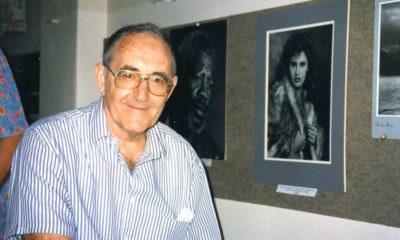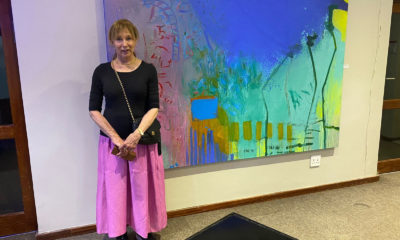
Lifestyle

Paper graves speak to the heart
Artist Jennifer Kopping’s exhibition at the Holocaust & Genocide Centre in Johannesburg is magical and poignant. Titled “Heartsounds”, it’s made up of intricate collages that use photos, passports, poetry, and other documents to reconstruct her family’s experience of the Holocaust, survival, emigration, and reinvention. The SA Jewish Report asked her more.
Where does the title, “Heartsounds”, come from?
From a line of my grandmother, Mina Zlotnick’s, poetry. She wrote, “… from my own heart’s sounds”. I found the phrase so poignant and profound.
You use many family heirlooms/documents in the work. What did you want to convey?
I was fortunate to have all these heirlooms, and they partly provided the inspiration for the artworks. Because they held such personal significance, they offered a conduit to the past and to memory. From an artistic point of view, I wanted to show the powerful connection between objects and memory, and how they carry meaning and can be transposed and applied to artmaking.
What inspired you to make collages?
I was inspired by a literary rather than an artistic genre – magic realism. Magic realism conflates time, place, and people from various geographic locales. It’s imbued with a sense of the mythological and spiritual. Using this as a starting point, I would describe my work as an innovative representation of how memory and a family, namely the Zlotnick and Bloch family’s diasporic narrative, is expressed – specifically within the context of the Holocaust, South Africa, and America. In my works, I converge and juxtapose a variety of locales, symbols, and times that intersect in my family’s diasporic journey from the shtetls of Lubcha and Iwye, in what was then Poland to South Africa and America.
The works are incredibly intricate. How long did they take you to produce? What materials did you use?
I used a range of media: paper, oil painting, collage, drawing, and embroidery. Most of the works are made from paper. The Yizkor memorial books (which were written by survivors or former residents of the towns who gathered in landsleit groups mainly in Israel, the United States, and South America) are poignantly described as “paper graves”, as no physical graves exist for those murdered in the Holocaust. I use paper metaphorically as a symbol of that loss. My works are, in a sense, paper graves.
The work evolved from two previous exhibitions submitted for examination as part of my PhD in practice-led research at the University of South Africa (Unisa). The first in New York at the Hebrew Union College and exhibited at the Dr Heller Museum in 2019. This exhibition was titled Scattered Breath – The Red Thread. It took a year to produce. The second body was exhibited at the Unisa Gallery in Pretoria (2021). It took another year. “Heartsounds” is an evolution of the previous exhibitions – in total, it took two years.
You did a lot of research – into Jewish history, mysticism, and so on. Where did you get your information?
Research is like doing a giant puzzle or detective work, so I consulted various websites on Jewish history, memory, and the Holocaust. I also consulted archives from the YIVO Institute for Jewish Research, and JewishGen provided valuable information on the Yizkor Books of the shtetls of Lubcha and Iwye. Unisa has an extensive library as well, and was most helpful.
Family members such as my aunt, Rachel Maister, and her son, Johnathan, in Canada provided photographs and transcripts of an interview with my grandfather, Isaac Zlotnick, who was a reverend for the Riversdale Jewish Community from the early 1930s. New York relatives Jean Rosensaft and Gloria Golan also shared their remarkable family history of their father, Samuel Bloch, uncle Martin Bloch, and grandmother, Sonia Bloch, and their experiences with the partisans in the Naliboki Forest.
Is there a best way for us to enjoy your works?
I use a mixture of vibrant colour and the sepia of old photographs to communicate the duality of life and death, which is the human condition. I want to give a sense of life affirmation and hope in the midst of trauma. The works are immersive, and so they allow the viewer to engage with them close up due to their detail, and from afar, in their totality. There’s a certain theatricality of the works derived from photography of the early 1900s, which were called tableau vivant (living pictures).
The subject matter – the Holocaust and its impact on your family – is sombre. But these works are warm and uplifting. Why?
The contrast of the bright colour and sepia gives a sense of life affirmation in the midst of death and loss and in so doing, is poignant and hopeful. Also this approach to my artmaking gives agency to the lost rather than victimhood.
Where are you planning to take the exhibition after this?
I would love it to be seen in Tel Aviv, Poland, and in the rest of South Africa, depending on funding. It has an important message about hope and remembrance of the Holocaust primarily, but also for all genocides and sites of trauma, as we see unfolding before us right now in Ukraine. Furthermore, it adds a familial dimension to how the personal and the collective are interconnected.
It has been a privilege to perpetuate the memory of the Holocaust, to give admiration and respect to the survivors, and to commemorate those that perished so that we can be aware of the dangers of prejudice and stereotyping. I also wanted to share the rich cultural and mythical beauty of Judaism.
- “Heartsounds” is at the Johannesburg Holocaust & Genocide Centre until 3 August.








